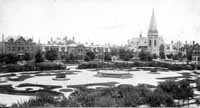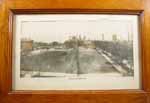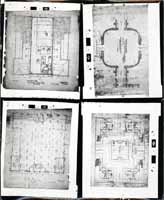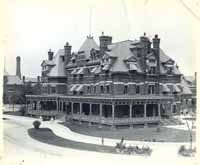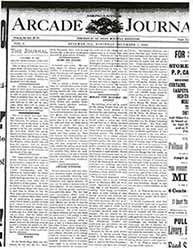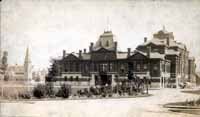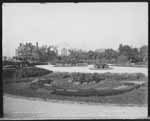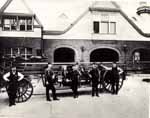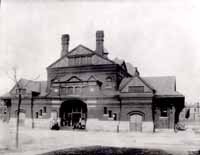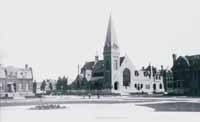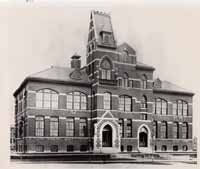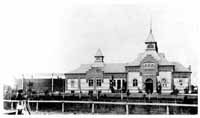Arcade Park
You are at Home -> The Town of Pullman -> Arcade ParkArcade Park
Nathan Barrett claimed to be the earliest proponent of the formal garden in America. To best accentuate formal gardens, he often juxtaposed them against what he called, "the naturalistic instinct" -- plantings carefully designed, but intended to create a wild or natural appearance. Arcade Park embodied this design penchant. The only formal garden in Pullman, Arcade Park boasted an interior planting scheme that was ultra-formal -- thousands of annuals, all trimmed to the same height (by Pullman company staff) and arranged to form geometric patterns. Surrounding this formal interior was a "naturalistic instinct" enclosure - dense, but not tall (so as not to obstruct the view) plantings of native wildflowers, shrubs and a few small trees. After years of neglect, Arcade Park was built to its current configuration in the 1970's, and is loosely based on the original layout. However the original planting scheme was not replicated, in large part because the upkeep of a large, manicured formal garden was deemed cost ineffective. The center section was hollowed out so that it could be flooded in the winter for ice skating. Unfortunately, the ice skating idea never worked. The flower beds, echoing the original configuration, are now maintained by the all volunteer Historic Pullman Garden Club.THE PULLMAN HISTORY SITE

More Information About the Town of Pullman
Planning the town
The Hotel Florence
The Arcade Journal
The Arcade
Arcade Park
The Stables
Market Hall
Area Churches
Area Schools
The Freight Depot and the Railway Station
Other Pullman Buildings
The Pullman House History Project
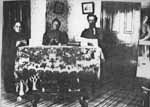
Arranged by:
Name
Address
Occupation
Birthplace
People of Color
Maps of Pullman
Images of the Town of Pullman
All images of the town
Vistas
Art & Architecture
- Landscape architect Nathan Franklin Barrett
- Architect Solon Spencer Beman
- Henry Koopman and Family, Photographer
- Landscape Design
Pullman’s Neighborhood
- The Calumet River
- IHACCR
- Area Churches
- The Kensington Neighborhood
- Lake Calumet
- North Pullman
- The Roseland Neighborhood
Buildings in Pullman
- The Arcade Building
- Arcade Park
- Carriage House
- Casino Building
- Fire Department
- Freight Depot
- Gas Works
- The Hotel Florence
- Hospital
- Houses
- Market Hall
- Schools
- Stable
- Train Station
Other Pullman-Related Sites
- Historic Pullman Garden Club - An all-volunteer group that are the current stewards of many of the public green spaces in Pullman. (http://www.hpgc.org/
- Historic Pullman Foundation - The HPF is a non-profit organization whose mission is to "facilitate the preservation and restoration of original structures within the Town of Pullman and to promote public awareness of the significance of Pullman as one of the nation's first planned industrial communities, now a designated City of Chicago, State of Illinois and National landmark district." (http://www.pullmanil.org/)
- The National A. Philip Randolph Pullman Porter Museum is a 501(c)3 cultural institution. Its purpose is to honor, preserving present and interpreting the legacy of A. Philip Randolph, Pullman Porters, the Brotherhood of Sleeping Car Porters and the contributions made by African-Americans to America's labor movement. ((http://www.nationalpullmanportermuseum.com/)
- Pullman Civic Organization - The PCO is a strong and vibrant Community Organization that has been in existence since 1960. (http://www.pullmancivic.org/)
- Pullman National Monument - The official page of the Pullman National Park. (https://www.nps.gov/pull/)
- South Suburban Genealogical & Historical Society - SSG&HS holds the Pullman Collection, consisting of personnel records from Pullman Car Works circa 1900-1949. There are approximately 200,000 individuals represented in the collection. (https://ssghs.org/)
- The Industrial Heritage Archives of Chicago's Calumet Region is an online museum of images that commemorates and celebrates the historic industries and workers of the region, made possible by a Library Services and Technology Act grant administered by the Illinois State Library. (http://www.pullman-museum.org/ihaccr/)
- Illinois Digital Archives (IDA) is a repository for the digital collections libraries and cultural institutions in the State of Illinois and the hosting service for the online images on this site. (http://www.idaillinois.org/)
